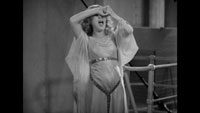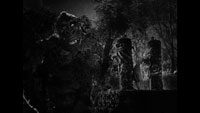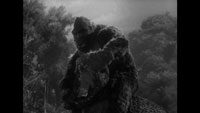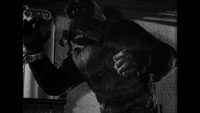****/**** Image A Sound A Extras A
starring Fay Wray, Robert Armstrong, Bruce Cabot
screenplay by James Creelman and Ruth Rose, from a story by Edgar Wallace and Merian C. Cooper
chief technician: Willis H. O’Brien
by Bryant Frazer Critics of a certain age point to Steven Spielberg’s Jaws and George Lucas’s Star Wars as the two new-style blockbusters that changed the course of moviemaking. It’s meant as a backhanded compliment to those films, whose high-concept efficiency appealed to huge audiences worldwide–and to younger viewers, it comes off as a geriatric complaint from Grandpa Sarris: “Get off my lawn, you kids with your laser guns and your killer sharks.” In truth, while Spielberg and Lucas altered the economics of the industry, they didn’t invent the modern blockbuster. That legacy stretches back to 1933, when the release of King Kong defined the studio tentpole for decades to come.
This monster movie, about a seagoing safari to capture an ape-like giant who lives with an uncontacted tribe somewhere west of Sumatra, was so groundbreaking in its execution that it suggested a whole other direction for cinema. Eat your heart out, Méliès. King Kong still feels bracingly modern–and not just because of the ingenious trick photography, which composited animated miniatures, matte paintings, and live-action photography into the same frame. The adventure score by Max Steiner and the sound design by Murray Spivack are more than groundbreaking specimens. They are actual top-drawer examples of the craft. (It’s a bit shocking to think of John Williams’s score or Ben Burtt’s much-lauded sound work for Star Wars and realize how little truly new ground had been broken in the 44 intervening years since King Kong.) And by casting the monster as an antihero whose rage against society results in his own destruction, directors Merian C. Cooper and Ernest B. Schoedsack found a way to make the story resonate with a mass audience.
King Kong‘s epigraph is an “old Arabian proverb” that sets up the film’s conception of a beautiful blonde woman who unwittingly beguiles a fearsome dark monster, leading to the beast’s ignominious doom. The woman is Ann Darrow (Fay Wray), an impoverished New Yorker who’s snatched off the streets by Carl Denham (Robert Armstrong), a travelogue impresario who convinces her to accompany his crew on their latest foray to a remote corner of the world. Their destination is Skull Island, where a narrow beachfront is home to savages who sacrifice women to Kong, a giant ape co-existing unpeacefully with dinosaurs, giant spiders, and other exotic creatures. Unbeknownst to Darrow and the rest of the crew, Denham’s plan is to capture Kong, sedate the great creature, and bring him back to New York, where he will be touted in appearances for paying audiences as “the eighth wonder of the world.”
Denham was a surrogate for Cooper, himself an experienced adventure filmmaker who specialized in dangerous wildlife and exotic locales. Denham’s first-mate, Jack Driscoll (Bruce Cabot), who eventually falls for Darrow, is a stand-in for Cooper’s longtime partner, Schoedsack. Cooper had read about the exploits of William Douglas Burden, who in 1926 had captured Komodo dragons, thinking them to be direct descendants of dinosaurs. Burden brought them triumphantly to the U.S., where they went on display at the Bronx Zoo and perished shortly thereafter. Cooper was struck by the idea of a magnificent and previously unknown creature dying upon its first contact with civilization. He eventually worked that idea into King Kong.
Kong fares little better than those lizards. He escapes his shackles on Broadway, recovers his beloved beauty, and carries her in his fist as he scales the tallest mountain on the island of Manhattan–the Empire State Building–in a stirring display of his power. As he swats at the biplanes that spray him with bullets, he keeps the woman out of the line of fire. Finally, the noble beast protects Darrow by leaving her behind before he loses his grip on the building and tumbles to his death.
No matter how fine your home-theatre set-up is, it’s worth trying to see King Kong on the big screen. The film is all about verticals. It’s hard to convey with mere words the sensation of staring up, up, up at those huge gates separating Kong from the Skull Island villagers as Darrow slumps dejectedly low in the frame, like a tethered goat, awaiting her enormous, as-yet-unseen suitor. (One problem shared by both the 1976 and 2005 remakes is their ‘scope frame; Kong is much scarier in the Academy ratio.) The seams of the VFX work are smoother, too–once you’ve reduced the image to fit a smaller screen and can take in the whole picture at a glance, the optical artifacts of Willis O’Brien’s visual feats are more apparent. To audiences at the time, though, the film must have seemed magical.
When you hear someone laud the fight between Kong and a bipedal dinosaur (an Allosaurus, apparently, though it’s commonly referred to as a T-Rex), which plays out in the background of the frame as Darrow looks on in terror, it’s easy to think, “Well, of course that would be cited as a great scene–it’s King Kong fighting a freaking dinosaur!” Yet beyond the obvious appeal of the idea to the 12-year-old boy inside everyone, the scene really is a masterful piece of work.
First off, it’s a technical marvel. The combination of live-action Fay Wray with stop-motion animation is effective, although seasoned viewers will easily note the presence of rear projection. It’s also a fine artistic accomplishment. Check out the animation as the two monsters stalk each other, stomping around the frame like a pair of wrestlers. O’Brien’s experience as a boxer informed his approach to the sparring creatures. Too, there’s an action beat that takes place when Kong is out of view so that Allosaurus is alone in the frame, his back to the camera but his face seen in profile. All that happens for a moment is that his tail swishes back and forth–the behaviour of an angry animal–to the accompaniment of a synchronized noise on the soundtrack that simultaneously suggests a rattlesnake and a jaguar. It feels primal, and it’s a wicked-cool fillip in a movie that’s full of wicked-cool fillips.
The scene ends with another amazing piece of animation. Kong gives up the fistfight and eventually brings the big dinosaur down with a wrestling move, grabbing Allosaurus in a headlock and then prying his mouth open ever wider until he snaps the monster’s jaw into pieces. Battle won, the big ape peers into the poor beast’s broken, bleeding maw and flops the bottom half of its face back and forth on its dangling hinge, like a strong child examining the remnants of a just-broken toy. It’s a terrific, painful moment that establishes Kong’s credentials as a rough beast.
And listen to the noise of the thing. Max Steiner’s score has faded away completely, so that what’s left are Wray’s terrified shrieks and gurgles and the sounds of Kong and Allosaurus going at it. They make wild jungle noises that are unsettlingly unnatural. (Murray Spivack’s arsenal of sound FX for the film included his recordings of a tiger’s roar slowed down and run backwards.) The whole Skull Island section of the film is remarkable in this way, full of clamorous and chaotic sounds that make the headlong onscreen bedlam not just spectacular but downright surreal. It feels like a nightmare. Steiner’s orchestral score, carefully calibrated to underline and comment on the unfolding action, heightened the melodrama and intensified the emotions. In 1933, only a few years into the history of talkies, sound filmmaking had its first masterpiece.
There’s a school of thought that lauds King Kong for its inarguable technical expertise but slags off practically everything else about it, from the minimal plotting and rote characterizations to the often-stiff silent-movie style of performance. (The ship’s Chinese cook is a cringeworthy Asian stereotype, though he’s not necessarily out of line with the characters who populated other Hollywood films of the period.) To some degree, it’s a fair complaint. The film’s first third is laden with lots of exposition and set-up, none of it having anything to do with what audiences paid for. But there’s a scene on the ship that’s as sophisticated and self-reflexive a take on genre filmmaking as anything you’ll ever see. Wearing a beautiful gown made of thin, clingy fabric, Darrow emerges from below deck for her screen test. As Denham cranks up his camera, he instructs her to look upward, towards the sky, and to react with horror to some unseen menace.
It’s a fascinating scene because, in taking a camera’s-eye view of Darrow’s performance, it blurs the line between Denham’s film and King Kong itself. Additionally, it’s as significant an observation about film acting as anything in Mulholland Drive. When Denham tells her to cover her eyes, the instruction is ironic, because it reminds us that the actress on a soundstage doesn’t actually see anything. Like Fay Wray, Ann Darrow is pretending to see something–covering her eyes becomes part of the charade that informs her performance. Denham ultimately ordering her to scream for her life, well…that specific direction is downright menacing. It underscores the predatory nature of his relationship with Darrow while speaking to the audience in a meta sense, not merely foreshadowing the terror to come but making an explicit promise of it.
With King Kong sneaking into release right before strict enforcement of the Hays Code began, Cooper/Schoedsack and O’Brien got away with a lot of stuff that wouldn’t pass muster a short time later. Indeed, when the film was re-edited for a subsequent Code-compliant reissue, some of its best moments disappeared for decades, such as shots where Kong was seen chewing up a native of Skull Island in his big grinning maw and grinding another to death in the earth beneath his giant feet.
That’s the thing about Kong. He’s a tragic figure and a cool monster, but he’s also sort of a dick. It’s not enough to trample villagers into the ground–he has to stomp on them vindictively. Once he starts climbing around the buildings of midtown Manhattan, he becomes a perverse voyeur, peering into apartment windows in hopes of finding Darrow secluded in her own urban habitat. At one point, he spots a lady who fits the bill and pulls her out of her bed into the air outside, where she dangles helplessly in Kong’s fist. When he realizes he’s holding the wrong woman, he simply lets her fall to her death–another horrifying example of Kong’s callousness that was later cut from the film.
A famous scene that vanished for years had Kong holding Darrow aloft and peeling off layers of her clothing. Midway through this mildly titillating striptease, he lifted his hand to his nose and sniffed twice, his nostrils flaring comically, as though he was surprised or puzzled by what he had gotten on his fingers. This is a riotously funny bit of animation–it’s gangbusters if you see it with an audience–and one of the highlights of the film. It, too, was lost for years. Wray isn’t nude in this scene, nor is there any implication of sexual assault. Presumably the censors just found the idea vulgar.
These minor trims might not seem like much in story terms, but the reduced violence, especially, changed the way Kong was perceived. In the censored version of the film, he started to become a bit more sympathetic. Cute and cuddly? Not quite–but not so dangerous after all. Some viewers came away from the film with the idea that Darrow grows sentimentally attached to the big fella, like a pet. They couldn’t be much more wrong–although that’s the direction taken by both remakes of the film, in 1976 and 2005, which seek to map the audience’s sympathetic response to Kong onto the film’s heroine. Peter Jackson, in particular, should have known better. The original Kong is a raw force of nature, and Ann Darrow never seems less than horrified by his presence in her life. He’s not lovable in any traditional sense, but the audience knows he can’t help what he is. That’s why Kong earns respect despite all the death he causes.
The film has been dogged since its release by accusations of racism. It’s true that the villagers of Skull Island are depicted simplistically and unsympathetically as a brutal ethnographic Other. Maybe it’s too easy for me, a 41-year-old white guy, to give Cooper and Schoedsack a pass for that, but that’s what I’m inclined to do. Mainstream Hollywood cinema is an inherently reductive medium, and anyway these two did not originate the idea of brutish people, rough beasts, or virgin sacrifices. A more troublesome aspect of the myth-making here is that we are told, repeatedly, that Kong’s undoing was merely his appreciation for the beauty that suddenly reveals itself to him. Are we to believe, then, that there was no such thing as beauty on Skull Island prior to the arrival of Denham and his band of fair-skinned mercenaries? That’s genuinely dispiriting–and it speaks uncomfortably to a certain chauvinism in pop culture that endures, in less bald-faced terms, to this day.
But there’s another way to read King Kong. The circumstances of Kong’s capture and exhibition are obviously redolent of the slave trade: He’s uprooted from his homeland and transported in the hold of a large cargo ship to America, where he is put to work for the white men holding him captive. Once he breaks free of his oppressors, they hound him as he makes his way through the steel and concrete jungle of the New World, powerful but ultimately impotent in his rage and pain. What kind of asshole roots against Kong when those biplanes come into the frame, bent on shooting him down? A film that depicts that struggle and suffering, positioning Kong not as ogreish terrorist but as powerful antihero, is no racist tract. It’s anti-racist. Granted, this interpretation does require the viewer to question as fundamentally disingenuous and ironic Denham’s famous parting shot against the poor dead creature. I keep thinking back to Cooper’s regard for those exotic Komodo dragons, essentially DOA in New York, and I have to believe he had more on his mind than ‘look at the pretty girl who tamed the wild animal.’ It wasn’t beauty killed the beast, Denham. It was greed and narcissism and amoral opportunism that did it. It was a hundred rounds of machine-gun fire that burst Kong’s chest open and sent him, reeling, down to the earth below. It was you.
Is that too progressive a reading to square with what we know about the people who made this film? Well, King Kong has not come up through these decades as a symbol of a raging ethnic libido shaking up the bourgeoisie by flying his freak flag from the top of the biggest phallic symbol in all of Western civilization. He’s endured as a tragic figure, a glorious prehistoric demigod snatched from the wilderness and reduced to a status lower than that of mere men. Take a look at the expression Willis O’Brien puts on Kong’s face in the final moments of his life, as the airplanes take him down. He’s not just defeated. He’s destroyed. His heart is broken. It’s simple, potent stuff, and it resists psychological and sociological pigeonholing. Thanks to a remarkable confluence of talent, it’s executed at a stunning level of technical virtuosity, with a showman’s sense of breathless pacing and one-upmanship. King Kong is a great time at the movies, and it’s one of the greatest films ever made.
| Click for hi-res BD captures |
 |
 |
 |
 |
Despite having seen the film quite a few times on television and on my beloved LaserDisc, which was based on the 1993 Turner restoration, for some reason I missed the highly-touted 2005 DVD release of King Kong. The extra features on this Blu-ray Disc contain lots of footage from the movie at DVD resolution, facilitating a comparison that mounts a terrific case for the HD version. Blu-ray skeptics will complain that the picture here looks grainier than the DVD, without revealing much extra detail in the frame, and there’s no way around it: they’re right. Blu-ray is adequate for revealing the limited resolving power of old-school film-camera lenses, as well as the shortcomings of elements that have gone through generations of optical duplication.
The difference is that this disc looks like 35mm film, with that distinctive, slightly gauzy curtain of grain, where the DVD footage is more evocative of a 16mm print glimpsed through a layer of dirty cheesecloth. DVDs don’t look as grainy as Blu-rays because the texture of the grain itself is smeared and reduced in detail–it’s a combination of the DVD lacking the pixels to resolve film grain and the aggressive compression algorithms that strive to reduce the amount of background detail that needs to be re-encoded from frame to frame. There may be the tiniest hint of digital artifacting in King Kong‘s VC-1 encoded Blu-ray picture–a faint blockiness to the grain patterns in the background of some shots–but it’s nothing you’ll notice unless you’re watching out for it.
Still-frame comparisons available elsewhere on the Internet (at DVD Beaver, for example) illustrate that the film was also reframed somewhat for BD, with extra information visible near different edges of the frame in different shots, indicating that Warner has treated the image a little more tenderly for this transfer. For example, the range of greyscale looks a bit smoother on Blu-ray, suggesting contrast was artificially boosted for the original DVD. As well, the film is pillarboxed to the technically correct post-1932 aspect ratio of 1.37:1, not 1.33:1 as noted on the disc cover. The Beaver‘s caps confirm the DVD was cropped to that ratio.
The original camera negative for King Kong disappeared many years ago, so this version has been pieced together from a variety of surviving elements, and there’s always a question of how the picture should look. Should it be, on Blu-ray, as grainy as a release print? A dupe negative? Warner has performed its typically fine balancing act here. Some noise-reduction and dust-busting obviously took place–still-frame captures can be found on the Internet that demonstrate a dramatic reduction in scratches and other unwelcome artifacts between the DVD and Blu-ray versions–but not at the expense of a highly film-like image. This Blu-ray doesn’t quite shimmer like a nitrate print, but its clean, clear appearance is leagues ahead of coarser, more contrasty versions of King Kong I’ve seen on 16mm and 35mm. It truly does justice to the film. As for those previously censored scenes: spotless. Finally, they look the way they were always meant to look.
Audio is DTS-HD MA 1.0 and it sounds terrific. There is no background noise or hiss to speak of, the track doesn’t sound overly filtered, and the noise floor doesn’t change distractingly as different sound elements are dropped into and out of the mix. I can’t imagine there’s a better way to study and appreciate the achievement of sound designer Murray Spivack. Meanwhile, though Max Steiner scholars will of course want to find soundtrack recordings, the first chapter of this disc features an instrumental overture that caught me by surprise. (It may or may not have been a feature of the film’s original engagement at the then-six-year-old Grauman’s Chinese Theatre in Hollywood.) It’s a fitting showcase for his work.
In terms of supplementary material, the awesome centrepiece of this package is RKO Production 601: The Making of Kong: the Eighth Wonder of the World, a standard-def doc (encoded with the VC-1 codec and in Dolby Digital 2.0) that runs more than two-and-a-half hours. Broken up into seven chunks, it’s worth watching the whole thing. It’s as much appreciation as information. Among the interview subjects are Peter Jackson, Frank Darabont, John Landis, Joe Dante, and many others, including high-powered present-day visual-effects supervisors who take the opportunity to kiss the figurative ring of Willis “Obie” O’Brien, the godfather of so many VFX techniques. It’s full of delicious info about the movie and its makers–the late Fay Wray appears in the flesh, as does Spivack, while old audio recordings of Cooper and Schoedsack are excerpted herein. The cherry on top of the sundae is the loving recreation, by Peter Jackson and VFX house Weta, of Kong’s notorious lost “Spider Pit” sequence, painstakingly reconstructed using the film’s script, storyboards, and surviving artifacts from the production as guidelines. The results are a lot of fun. They weren’t inserted into the movie itself, but they’re presented in a separate HiDef short running exactly six minutes.
A second near-full-length doc is I’m King Kong! The Exploits of Merian C. Cooper (57 mins., SD). Warner went in with TV channel Turner Classic Movies to commission directors Kevin Brownlow and Christopher Bird for this lovingly researched hagiography on the film’s colourful co-director. It’s hard to tell whether we get a real measure of the man from stuff like this, and I certainly wish Brownlow and Bird had made even cursory mention of his political leanings, which apparently included an endorsement of Joe McCarthy’s Communist witch hunts. Still a touchy subject, I suppose.
There’s also nearly five minutes of test footage from Creation, the movie Obie abandoned for King Kong, running at HD resolution with awesome Ray Harryhausen commentary. (Surprisingly, it’s even subtitled.) The stop-motion guru, who worked with Obie on Mighty Joe Young, also contributes his insight to an engaging feature-length audio commentary along with hotshot VFX supe Ken Ralston. They’re joined in their infectious reverie by auditory remnants of Cooper and Wray, who are represented in brief interview snippets that come and go in ghostly (and somewhat distracting) fashion. I was scandalized to learn that executive producer David O. Selznick wanted to cut the “scream for your life” scene. Philistine! The only element that’s a bit of a throwaway is a trailer (in SD) for one of the film’s many reissue engagements. This is a terrific set–a sterling chunk of film history on a shiny silver platter. I couldn’t recommend it much more highly.
On the packaging itself: I’m not a fan of Blu-ray “DigiBooks” in general, but this one is pretty classy, with ferocious Kong artwork on matte-finished front and back covers. Sandwiched inside is a 32-page glossy booklet filled with film stills, production photos, various artwork, and a good set of liner notes by historian Rudy Behlmer. The booklet would be much easier to read if it were slipcased next to the disc’s case, Criterion-style, instead of built into it, but that’s quibbling.
104 minutes; NR; 1.37:1 (1080p/MPEG-4); English 1.0 DTS-HD MA, Spanish DD 1.0; English SDH, French, Spanish subtitles; BD-50; Region-free; Warner

![King Kong [Blu-ray Book]](https://m.media-amazon.com/images/I/51qECcjoaGL._SL500_.jpg)


![The Rocky Horror Picture Show (1975) + Shock Treatment (1981) [Bodice-Ripping Fabulous 3-Disc Set] - DVD 6a0168ea36d6b2970c017ee3d3e4d7970d](https://filmfreakcentral.net/wp-content/uploads/6a0168ea36d6b2970c017ee3d3e4d7970d.jpg)

